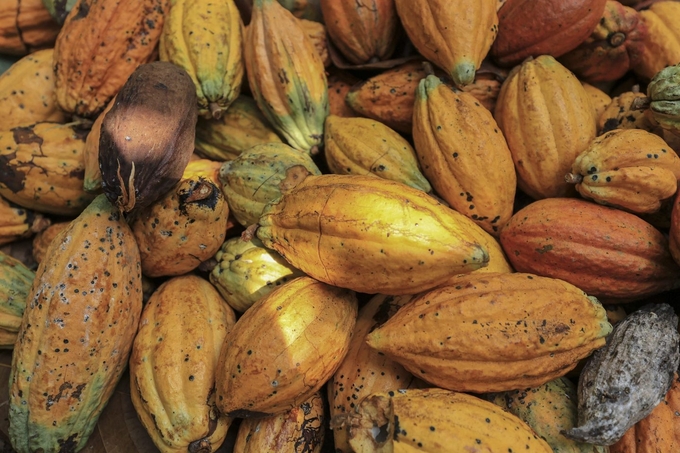December 1, 2025 | 17:17 GMT +7
December 1, 2025 | 17:17 GMT +7
Hotline: 0913.378.918
December 1, 2025 | 17:17 GMT +7
Hotline: 0913.378.918

Cocoa prices have almost tripled this year as faltering production in West Africa spurred massive supply shortages.
Prices have almost tripled as faltering production in West Africa — the world’s biggest growing region — spurred massive supply shortages. Many traders, burned by soaring costs to maintain positions, fled the market as the rally gained steam, and chocolate makers sat out hedging new inventory in a bid for lower prices.
But harsh weather and a virulent crop disease have raised fresh concerns about this season’s harvest, lifting New York futures to an all-time high of nearly $13,000 a ton just this week. However, in a market that could continue rallying, some chocolatiers aren’t waiting anymore to lock in prices. The already-low futures liquidity is also adding to the wild swings, sending cocoa’s gains even beyond Bitcoin.
“At these levels it’s all pain,” said Vladimir Zientek, a trading associate at financial services firm StoneX Group Inc. “As we have seen countless times this year, if this market wants to trend in one direction, it has all the power to do so.”
The cocoa market had cooled, after surging to just under $12,000 a ton in April, on expectations of better harvests in West Africa. The rally resumed in November as the weather became unfavorable for crop development, dimming hopes of a significant recovery.
“It doesn’t really look like anything on the supply side got fixed this year and we’re really one hiccup away from having a fourth consecutive deficit,” said Zientek. “If we have that drop, are we really going to have enough cocoa to fulfill the old contracts and the new contracts that’ve been forward sold?”
Both Ivory Coast and Ghana are still grappling to fulfill contracts they were forced to roll over from the last season.
The relentless advance has caused pain on several fronts, especially for chocolatiers who sat out hedging new inventory waiting for prices to continue cooling. Now, confronted with record-high prices, their frantic buying has helped fuel the market higher.
Maintaining short positions has also become “prohibitively more expensive,” forcing some players to exit the market as they “don’t have the ability or willingness to refinance these losing positions,” said Stephen Butler, chief commercial officer at ChAI, a platform that uses AI to analyze commodity markets.
Limited selling of futures by commercial players, after last season’s shortfall in bean deliveries, has helped drive their gross short positions in the New York exchange to the lowest seasonal level since 2011, according to JPMorgan Chase & Co. analyst Tracey Allen. That has further drained liquidity, making the market even more vulnerable to large price swings.
Cocoa shipments from top grower Ivory Coast have fared well so far, running about 33% ahead of last season’s pace, according to data compiled by Bloomberg. But the increase is “somewhat misleading,” as the previous year’s level was very low, Commerzbank analysts said in a Tuesday note.
Following a sharp drawdown in global stockpiles, the buffer is small if West Africa’s crop disappoints, “which increases the risk of price spikes,” the analysts added.
While prices for raw beans have surged to records, an increase in cocoa butter costs — a key chocolate ingredient extracted from them — has been tempered by weakening demand, according to data from KnowledgeCharts, a unit of Commodity Risk Analysis. That could cap price gains next year as chocolate makers switch away to equivalents made with ingredients like palm oil.
“Demand is uncertain at this point and grinding data for the fourth quarter will be closely scrutinized when released in mid-January for any indication of destruction,” said Allen. The current price levels will more likely be felt in demand in the second quarter of 2025, she added.
fortune

(VAN) The signing of a protocol between Viet Nam and China on the export of fresh jackfruit represents a significant milestone in agricultural trade cooperation between the two countries.

(VAN) On November 27, the Ninh Binh Department of Agriculture and Environment and the Institute for Green Growth Research organized a training course on greenhouse gas inventory for businesses.

(VAN) China’s cooking oil is suddenly flooding into India. It all comes down to a soybean surplus that Beijing doesn’t quite know what to do with.

(VAN) An Giang promotes supply-demand connections, standardizes quality and builds value chains, creating a foundation for sustainable bird’s nest development and aiming to expand exports.
/2025/11/24/5339-4-nongnghiep-075331.jpg)
(VAN) Recently, the conference on 'Sustainable Fisheries Linkage Chain - Tilapia for Export' took place in Tien Hai commune, Hung Yen province.
/2025/11/21/4309-2-153400_128.jpg)
(VAN) Green and low-emission rice is paving the way for Vietnamese rice to enter high-end markets, marking the beginning of a transformation journey toward greening and elevating the national rice brand.

(VAN) ‘Right to Win’ outlines a national action plan that shapes a new vision for Viet Nam’s agriculture in an era of renewal and global integration.